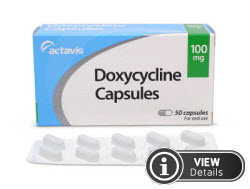How much Doxycycline is effective for ureaplasmosis (ureaplasma)
Content:
- Features of the drug Doxycycline
- About ureaplasmosis
- Advantages of doxycycline in comparison with its analogues
- Doxycycline release forms and treatment regimen
- How to take doxycycline with ureaplasma
- Side effects and contraindications of doxycycline
- Interaction of doxycycline with other drugs
- Special recommendations
 Doxycycline is a broad-spectrum antibiotic that can destroy large colonies of bacterial pathogens. Its effect extends to streptococcal, staphylococcal, anaerobic, pneumococcal, intestinal and mycoplasmal infections.
Doxycycline is a broad-spectrum antibiotic that can destroy large colonies of bacterial pathogens. Its effect extends to streptococcal, staphylococcal, anaerobic, pneumococcal, intestinal and mycoplasmal infections.
Features of the drug Doxycycline
 The drug doxycycline belongs to the group of tetracyclines, it was artificially synthesized in 1967 by American scientists, passed the necessary tests and proved itself in medical practice.
The drug doxycycline belongs to the group of tetracyclines, it was artificially synthesized in 1967 by American scientists, passed the necessary tests and proved itself in medical practice.
In medicine, doxycycline is used against ureaplasma. This is due to its activity against this microbe. It easily penetrates the membrane envelope into infected cells and destroys the pathogen by suppressing the synthesis of protein fractions and enzymes. The death of the microorganism occurs quickly, since even a small amount of doxycycline has a negative effect on all processes of its vital activity. The effectiveness of the use of doxycycline from ureaplasma is based on the bacteriostatic effect of the drug, its ability to stop the growth, nutrition and reproduction of these microorganisms.
Briefly about the disease ureaplasmosis (ureaplasma)
 Ureaplasmosis is caused by a microscopic bacterium (Ureaplasma) from the genus Mycoplasmas, which is able to affect the mucous membranes of the urino-genital and respiratory organs of a person. Infection occurs in two ways. The most common - sexual (through intimate proximity), a rare - household (through dishes, linen, hands). A microbe is devoid of a cell membrane, but has a lipid membrane, so to maintain its vital activity, it must be parasitized in a foreign organism. Because of this feature, the microorganism is referred to as intracellular, i.e. are considered to be a type of pathogens that provide their own survival by feeding substances from the human body.
Ureaplasmosis is caused by a microscopic bacterium (Ureaplasma) from the genus Mycoplasmas, which is able to affect the mucous membranes of the urino-genital and respiratory organs of a person. Infection occurs in two ways. The most common - sexual (through intimate proximity), a rare - household (through dishes, linen, hands). A microbe is devoid of a cell membrane, but has a lipid membrane, so to maintain its vital activity, it must be parasitized in a foreign organism. Because of this feature, the microorganism is referred to as intracellular, i.e. are considered to be a type of pathogens that provide their own survival by feeding substances from the human body.
A characteristic feature of ureaplasma is its ability to "doze" in the body for a long time. Only with a sharp weakening of the protective forces of the carrier (cooling, overheating, serious diseases, immune pathologies, deterioration of living conditions), the bacterium manifests itself. Therefore, science classifies it as a conditionally pathogenic flora.
Medical research confirms that, with resistance to many antibacterial agents, ureaplasma is successfully treated with doxycycline or its analogs. Such manifestations of the disease as: inflammation, edema, burning and itching in the region of the genito-urinary organs decrease after the first two days of using the antibiotic.
In order to prevent re-infection, it is necessary to avoid factors that provoke the disease, have one healthy sexual partner, observe personal hygiene rules, strengthen immunity and lead a healthy lifestyle. A special feature in the treatment of urogenital ureaplasmosis is the need to take doxycycline by both partners, during the course of therapy the intimate life stops.
Advantages of doxycycline in comparison with its analogues
The medicine has a number of positive characteristics:
- ureaplasma bacteria are very sensitive to its effects;
- it is effective even in small (standard) concentrations, so therapy is performed with the usual dosage, without increasing it;
- when administered orally (oral, ie through the mouth) is absorbed 100 percent;
- it is highly soluble in fatty media, which is especially important for ureaplasma, which has a lipid membrane;
- quickly accumulates in the inflamed zones (the maximum concentration of the drug in the blood comes after 2 hours after administration);
- can be permanently retained in tissues and organs (within 24 hours), i.e. has a prolonged action;
- accumulates in the human body (deposited in inflamed zones), which enhances its bacteriostatic effect;
- the intake of food does not weaken the effect of the drug, it is completely absorbed by the body;
- easy to use (used once a day, rarely - 2 times, at regular intervals);
- has a narrow list of side effects (in comparison with other drugs of the penicillin group);
- practically does not affect the beneficial flora of the intestine; always available in the pharmacy network;
- has budgetary value and a wide choice on the manufacturer (it is made in Belarus, Switzerland, Germany, Austria, Russia and other countries).
Doxycycline is completely eliminated from the body after 72 hours with bile, urine, feces, saliva and sweat. The maximum accumulation of the drug is observed in the genito-urinary organs, nasal sinuses, gingival pockets, tonsils, pulmonary and hepatic parenchyma.The medicine penetrates well through the blood-brain and placental barriers into the mother's milk.
Doxycycline release forms and treatment regimen
Doxycycline is available in the following forms:
1. Gelatin capsules with a powder of white or yellowish color (50, 100, 200 mg) 10 pieces in a carton.
2. Lyophilizate preparation for the preparation of a solution for intravenous infusion (ampules or bottles with dry matter from 100 to 200 mg).
3. Solution for injection of 5 ml.
Keep the drug in a cool place, it has a long shelf life (4 years).
To order Doxycycline capsules online, you may visit official store buy the link.
How to take doxycycline with ureaplasma
The doctor determines, depending on the stage of the disease, its severity and the general condition of the patients. Usually the drug is taken once a day after meals, washed down with a glass of water (to avoid irritation of the esophagus), taking the reception for one to two weeks. Treatment is combined with taking probiotics to prevent dysbacteriosis (imbalance of bacterial flora in the intestine).
Sometimes the treatment of ureaplasmosis is carried out starting with a shock dose (200 mg), then it is reduced to a standard dose (100 mg) and adhered to such a scheme until the end of the course of treatment. In severe forms of ureaplasmosis doxycycline is prescribed intravenously drip. On the first day of 200 mg, then 100 mg, up to 300 mg per day for 1-2 infusions.
For children, the drug is calculated according to their weight (from 1 to 4 mg per 1 kg of body weight). The product has a bitter taste, so it is important to prevent damage to the capsule when swallowed by the child, i. E. provide it with a sufficient amount of liquid for drinking.
Side effects and contraindications of doxycycline
Despite the low toxicity to other tetracycline drugs, doxycycline has a number of adverse effects on the patient's body.
- Changes in liver function, deterioration of its enzymatic activity.
- Failures in the activity of the stomach: a decrease in appetite, the appearance of nausea, vomiting, flatulence, gravity in the abdomen, impaired motor function, food digestion processes, the emergence of gastritis, the formation of erosions or ulcers.
- The phenomenon of intestinal dysbacteriosis (disorders of stool and absorption of nutrients), the onset of inflammatory bowel diseases (enteritis, colitis).
Dysfunction of the nervous system: the appearance of increased irritability and nervousness, sleep disturbance, dizziness, migraine pain.
- The emergence of allergies: urticaria, itching and puffiness of the skin, lachrymation, runny nose, sneezing, short-term coughing attacks.
- Changes in the composition of the blood (eosinophilia, anemia, leukopenia).
- Negative effect on tooth enamel (its destruction, plaque formation, discolouration).
- Violation of the processes of thermoregulation (the appearance of chills, excessive sweating, feelings of heat).
 Attention! The use of doxycycline during the formation and growth of molars in children can forever change their color from natural to yellow (light brown). Dental correction of this color of enamel is not possible!
Attention! The use of doxycycline during the formation and growth of molars in children can forever change their color from natural to yellow (light brown). Dental correction of this color of enamel is not possible!
Among the contraindications can be identified:
- Children up to 8 years.
- The second and third trimester of pregnancy (there are studies with data on the delay in the formation of the fetal skeleton on late gestation and the formation of bone anomalies with the use of doxycycline by the mother).
- Diseases of the hematopoietic system (leukemia, hemophilia, thrombopenia).
- The period of breastfeeding.
- Allergic predisposition.
- Individual intolerance to the drug.
- Expressed pathologies of the digestive system with erosive processes or ulceration of mucous membranes.
- Severe hepatic failure.
- Porphyria.
Interaction of doxycycline with other drugs
- The combined use of this drug with penicillins reduces the anti-inflammatory effect of both.
- The intake of calcium, magnesium, phosphorus, iron against the background of doxycycline reduces its therapeutic effect.
- Application along with indirect anticoagulants can lead to the development of bleeding.
- The combination with methoxyflurane (anesthetic) can provoke an exacerbation of liver diseases and the development of its insufficiency.
- Along with the simultaneous use of methanol, the drug can cause jumps in intracranial pressure.
- Doxycycline forms stable chemical compounds with calcium and promotes their deposition in the bone system.
- Barbiturates reduce its anti-inflammatory effect.
Special recommendations
- During the course of treatment can not be in the sun, unexpected reactions and skin color changes (blanching, redness, pigmentation formation) are possible.
- Before the beginning of treatment it is necessary to make a test for the susceptibility to the drug, with the resistance of the organism to it another antibiotic is prescribed.
- Do not use with alcohol, which speeds up absorption of the drug, but reduces its anti-inflammatory effect.
- To take doxycycline together with contraceptives is possible only after consulting with a gynecologist, the drug significantly reduces their effectiveness and increases the risk of uterine bleeding between cycles.
- Antacids (Fosfalugel, Almagel) reduce the absorption of antibiotic from the stomach and intestines.
- Do not need to use doxycycline before routine surgical interventions, because it enhances the effect of anticoagulants, often used during operations.
Self-administration of the drug is unacceptable, it can lead to a temporary disappearance of symptoms, but under the imaginary recovery latent infection will be hidden with harmful consequences for the body. It is also possible to develop negative reactions to doxycycline with serious complications for the health and life of patients.
